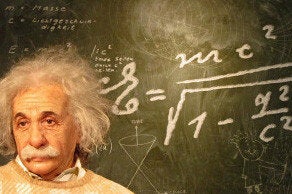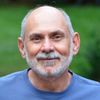
In three previous posts we've discussed assumptions that science once embraced, later to discard as invalid or unnecessary. Thus far we've dispatched with absolute time and space (Part 2), determinism (Part 3), and dualism (Part 4). Today we examine the principle of local causes.
*****
Einstein, who deposed Newton, grew intellectually stodgy in old age. With respect to quantum mechanics (QM), he was positively reactionary. A die-hard determinist, Einstein rejected the statistical implications of quantum theory. In a letter to his friend and fellow physicist Max Born, Einstein confided: "Quantum mechanics is very impressive. But an inner voice tells me that it is not yet the real McCoy. The theory produces a good deal but hardly brings us closer to the secret of the Old One."
By 1935, Einstein believed he had found the Achilles heel of QM. With two coworkers, he pitched a heroic attempt to expose its fatal flaw by posing what became known as the "EPR paradox."
Strictly speaking, paradoxes are unresolved; not so for EPR. Einstein lost, and QM won. However, in 1935, when Einstein, Boris Podolsky, and Nathan Rosen posed their fiendishly clever gedanken experiment, a betting person might have put odds on Einstein's team. QM must be incomplete, Einstein felt instinctively. The probabilistic appearances of quantum events -- such as the spontaneous decay of a radioactive element, for example -- were mirages, he surmised, the result not of any propensity of the natural world toward statistics but rather of our incomplete knowledge of nature. Einstein hypothesized the existence of "hidden variables" of which the current theory remained ignorant. If the hidden variables were exposed to the light of day, he argued, the apparent statistical predilection of nature would evaporate.
*****
As the originator of the theory of relativity, Einstein held the principle of local causes to be inviolate. According to special relativity, the velocity of light in vacuo, denoted c, plays the role of a universal speed limit, faster than which travel is forbidden by physical impossibility. Nothing -- neither matter nor information -- should be able to rove from point A to point B faster than a beam of light can make the transit.
To illustrate, suppose we humans unwisely break the atmospheric test-ban treaty, detonating a nuclear weapon. Aliens presumably will be unaware of the ominous event until photons from the flash on earth reach their distant planet. Most physicists, Einstein included, regarded as absurd the thought that an event at one point in space could instantaneously effect an outcome in a distant region.
QM, Einstein inferred, violated the locality principle. Sporting the title "Can Quantum-Mechanical Descriptions of Physical Reality Be Considered Complete?," the EPR paper considered simple, two-particle quantum systems. Quanta -- whether electrons, positrons, or photons -- involve a property called spin. It is a helpful analogy to think of such particles as spinning about an axis like a top. Spin, a form of angular momentum, is defined by an axis of rotation and an angular velocity. For subatomic particles, spin is quantized: spin magnitudes must be whole or half multiples of Planck's constant h. For photons of light, spin is synonymous with polarization. Photons carry spin magnitudes of plus or minus 1. No other values are permitted by nature.
Now consider the simplest aggregate of quantum particles: a two-particle system consisting of one spin-up (+1) photon and one spin-down (−1) photon. The net spin momentum is thereby zero, the sum of the individual spins. By conservation of angular momentum, the net spin of the system must remain zero for all time.
And now things get interesting. As a quantum of angular momentum, spin is subject to Heisenberg's uncertainty principle, with two enormous implications. First, until measurement, a particle's spin exists only as a probability, not as a reality. Second, the act of measuring spin determines its actual value.
Now to Einstein's punch line. Consider the creation of a two-particle system of net spin zero, comprised of two photons, each traveling horizontally at velocity c in opposite directions. Suppose further that the two photons are now separated by an enormous expanse of space. Suppose finally that we measure the spin of one photon, which fixes its spin. According to quantum theory, the other must simultaneously register a spin value exactly opposite that of its twin in order to preserve angular momentum. But how does the distant twin know instantly what spin value to assume?
Einstein believed that he held QM by the soft parts. He closed by springing the trap:
"One can escape from this conclusion [that quantum theory is incomplete] only by either assuming the measurement of [particle 1 telepathically] changes the real situation at [particle 2] or by denying independent real situations as such to things which are spatially separated from each other. Both alternatives appear to me entirely unacceptable."
Einstein euphemistically termed such mysterious (and presumably impossible) "telepathic" or "superluminal" communication by the colorful phrase "spooky action at a distance." And so the EPR paradox rested for 30 years, a full-fledged, unresolved, perplexing conundrum about the nature of reality.
*****
Then, in 1964, John Stewart Bell, an Irish physicist associated with CERN (the Euroean Center for Nuclear Research), proved a theorem directly related to EPR. Bell's theorem is extraordinary for several reasons. Foremost, it's a theorem, not a theory. Theorems, which are mathematical, rest on the solid foundation of formal logic and carry 100 percent certitude. In particular, Bell's theorem established a mathematical inequality by which to experimentally test whether the principle of local causes is valid or the statistical predictions of QM are valid. However, there had to be a winner because the two outcomes are mutually exclusive.
In the decade following the publication of Bell's theorem, numerous physicists reformulated and sharpened the argument. By the early 1970s, experimentalists had posed a version involving photon polarization that could be tested in the laboratory. In 1972, Stuart Freedman and John Clauser of Lawrence Laboratory performed the long-awaited experiment to resolve the EPR paradox. By generalizing Bell's inequality, they directly tested Einstein's assertion that hidden variables could preserve local causes. The results were unequivocal: "Our data, in agreement with quantum mechanics, ... provid[e] strong evidence against local hidden-variable theories." Spooky action at a distance prevailed.
*****
The modern term for spooky action is quantum entanglement. The term suggests that quantum particles entangled "at birth" remained entangled forever despite the intervening distance. One is reminded of the psychic connections widely reported by human twins. Once connected, always connected, it seems.
In 1975, shortly after the first experimental test of Bell's theorem, a prescient physicist, Henry Stapp, went out on a limb to write in a governmental report: "Bell's theorem is the most profound discovery of science."
At the time, it is doubtful that many concurred. Today, Stapp's words ring true. Quantum entanglement, now well established, is quickly making its way into a variety of applications, from cryptography to quantum computing. Bell's theorem may be the Cullinan diamond of physics' many gems. By revealing quantum entanglement, Bell's theorem exposes subtle and mysterious interconnections that may lie outside the universe's spacetime fabric.
Had Einstein been buried rather than cremated, he would be turning in his grave.
(This essay was adapted from Chapter 11 of Reason and Wonder.)
